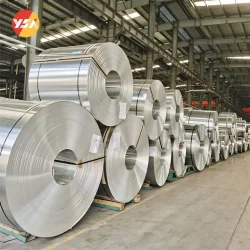Wide aluminum foil
Wide aluminum foil are commonly seen in industries where aluminum foil rolls are wider for specific needs like packaging, insulation, and electronics industries. These rolls can exceed widths of over a hundred centimeters and are custom-produced based on customer requirements and specifications.
Household aluminum foil rolls, on the other hand, are typically narrower, ranging from 30 centimeters (12 inches) to 45 centimeters (18 inches). They are specifically designed for everyday household use such as food wrapping, baking, and cooking.
Yongsheng Aluminum foil
Yongsheng Industrial Foil
Thickness: 0.001-0.2mm , Width: up to 2600mm(2.6m).
Available in all alloys and tempers.
| Alloy | 1xxx Series: 1050, 1060, 1070, 1100, 1235 |
| 3xxx Series: 3003, 3004 | |
| 5xxx Series: 5052 | |
| 8xxx Series: 8011, 8021, 8079 | |
| Temper | F, O, H14, H16, H18, H19, H22, H24, H26, H28, T etc. |
| Thickness | 0.006-0.2mm. |
| Width | 20mm-1600mm (1.6m). |
| Diameter | Inner Diameter: 76/152 mm; Outer Diameter: Support Customization. |
Good thickness consistency. Free sample.
| Delivery Time | Ready stock 7-10 days, on time delivery guaranteed |
| Loading Port | Qingdao Port, Tianjin Port, Shanghai port. |
| Price Terms | FOB, CIF, CFR, EXW etc. |
| Payment | L/C, T/T, Western Union, etc. |
| Quality Control | Third Party Inspection. Mill Test Certification is supplied with shipment. |
| Certificates | MTC, ISO9001,SGS, ROHS,DNV,TUV,ISO14001,ABS,CCS,CE |
| Standards | ASTM-B209, EN573-1, GB/T3880.1-2006, GB/T 24001-2016, GB/T 19001-2016 |
How do you calculate the thickness of aluminum foil?
To calculate the thickness of aluminum foil, you can use a micrometer or caliper to measure its thickness directly.
- Take a small piece of aluminum foil that is representative of the foil you want to measure.
- Ensure the foil is flat and free from any wrinkles or creases.
- Use a micrometer or caliper to measure the thickness of the foil.
- Place the jaws of the micrometer or caliper on either side of the foil and gently close them until they make contact with the foil surface.
- Read the measurement displayed on the micrometer or caliper. It will give you the thickness of the aluminum foil in units such as millimeters (mm) or micrometers (µm).
Aluminum foil is extremely thin, the typical measurement is in micrometers. The thickness can range from around 0.01 mm (10 micrometers) to 0.03 mm (30 micrometers) for household foil. Industrial foil may have different thickness specifications depending on its intended application, from 0.006mm (6 microns) to 0.2mm (200 microns).

Common thicknesses for aluminum foil
- 0.006mm (6 microns)
- 0.010mm (10 microns)
- 0.012mm (12 microns)
- 0.018mm (18 microns)
- 0.020mm (20 microns)
- 0.040mm (40 microns)
- … …
- 0.2mm (200 microns)
FAQ: Does aluminium foil block rfid?
Does aluminium foil block rfid? Yes, aluminum foil can effectively block RFID (Radio Frequency Identification) signals. RFID technology uses radio waves to transmit data wirelessly, and aluminum is a good conductor of electricity and can act as a barrier to these radio waves.
When aluminum foil is wrapped around an object or used as a shield, it creates a Faraday cage effect. This cage blocks or attenuates the RFID signals, preventing them from reaching or being transmitted from the RFID tags or devices.
The effectiveness of aluminum foil in blocking RFID signals can depend on various factors, including the thickness and quality of the foil, the strength of the RFID signal, and the proximity of the foil to the RFID tags. While aluminum foil can provide some level of protection, it may not completely eliminate all RFID signals.
RFID (Radio Frequency Identification) is a technology that uses radio waves to wirelessly identify and track objects or individuals. It involves the use of RFID tags, which are small electronic devices that contain a microchip and an antenna. These tags can transmit information to an RFID reader when they are within range. Aluminum foil can be used as a simple and inexpensive method to block or attenuate RFID signals.

